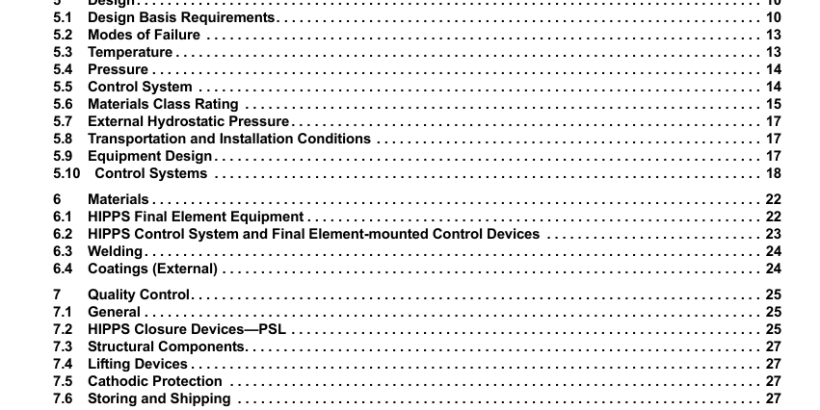API RP 17O:2009 pdf free download.Recommended Practice for Subsea High Integrity Pressure Protection Systems (HIPPS)
4.1.2 HIPPS SIS, defined by this document, provides pressure protection to downstream components.
4.1.3 Subsea Fortified Zone A fortified section may be located downstream of the HIPPS isolation valves to allow time to respond to the system closure determined by the pressure transient calculations.
The response time to system closure will be dependent on the nature of the flow for the specific system and would include consideration of the gas-oil-ratio (GOR). The pressure rating of the fortified section will be project-specific and will range from the maximum allowable operating pressure (MAOP) of the flowline/pipeline, to the same as the full rating of the pressure source (e.g. subsea tree). The length of the “fortified” section should be determined based on flow analysis.
The use of alternative flow assurance methods (i.e. chemicals) should not be considered when determining the length of the fortified section. It is conceivable that this section may not be required, but this shall be proven based on flow analysis.
4.1.4 Unfortified Zone (Flowline)
The unfortified zone is downstream of the fortified zone and upstream of the host zone. The location of the unfortified zone shall be determined by the hydraulic analysis and be dependent on the impact of any eventual leakage risks to be mitigated. The hydraulic analysis should include all potential system transients (multiphase/slug flow, etc.). The unfortified zone shall be located to minimize risk of injury to people and damage to infrastructure and the environment. Design should also take into account the need for system testing. The unfortified zone would be proven to function by hydraulic analysis, design, and testing as appropriate.
4.1.5 Host Fortified Zone The near-platform riser section should be designed such that release of hydrocarbon or hazardous materials occurs away from the facility to protect personnel. Near-platform riser section refers to a region, which if breached by high- pressure excursions, could result in damage to the facility or threat to life. 4.1.6 Topsides A process safety valve (PSV) can be used to relieve build up of pressure due to valve leakage. The PSV would be located between the flowline isolation valve (FIV) and the boarding shutdown valve (BSDV). Consideration needs to be given to safe venting of fluid, particularly during a platform shutdown or unmanned situation.
4.2 Production Characteristics Design of all product-containing systems shall consider the fluid and gas properties being transported and select materials and welding processes fully compatible with planned products. For multiphase production systems, the full range of GOR, water production rates, sand, carbon dioxide, hydrogen sulfide, injected chemicals, and other products shall be fully investigated during analysis and design.
4.3 Flowline Rupture Considerations Design of the flowline downstream of a HIPPS shall consider the possibility of failure of the HIPPS to correctly function. The design should determine the likely consequences and design mitigations to minimize each consequence. Some of the key consequences of failure of the HIPPS and possible mitigations to consider include the following.
— Uncontrolled—In this case, the flowline ruptures and inventory is released to the environment. The system shall be arranged so that any pipeline burst occurs within the protective segment. Protection of human life is the highest priority. An environmental remediation plan should be in place.
— Controlled but Uncontained—In this case, there is a pressure-relieving mechanism which minimizes the quantity of product released. An environmental remediation plan should be in place.
— Controlled and Contained—In this case, there is a pressure-relieving mechanism (preferably self-resetting) which contains the release. The capacity of the containment system shall be defined.API RP 17O pdf download.API RP 17O:2009 pdf free download
